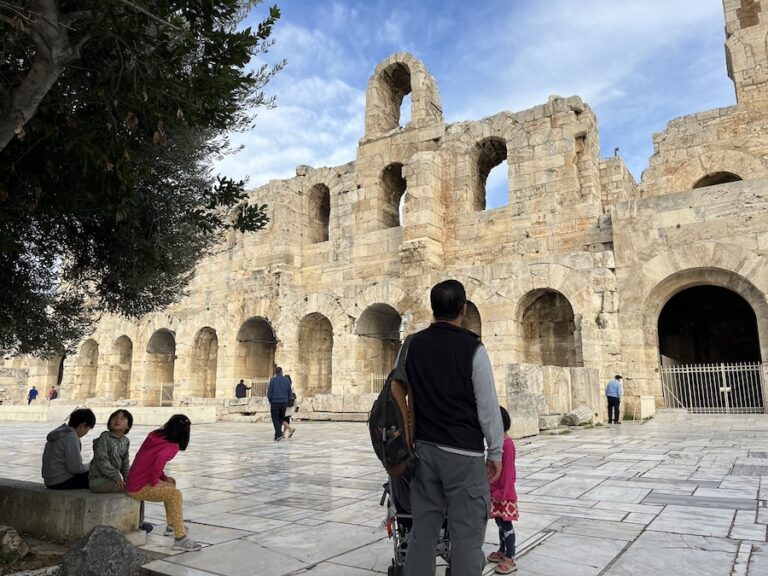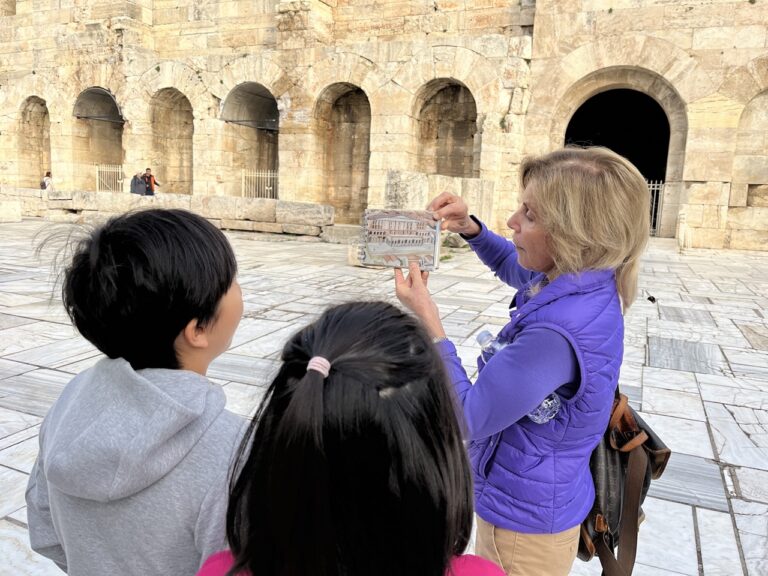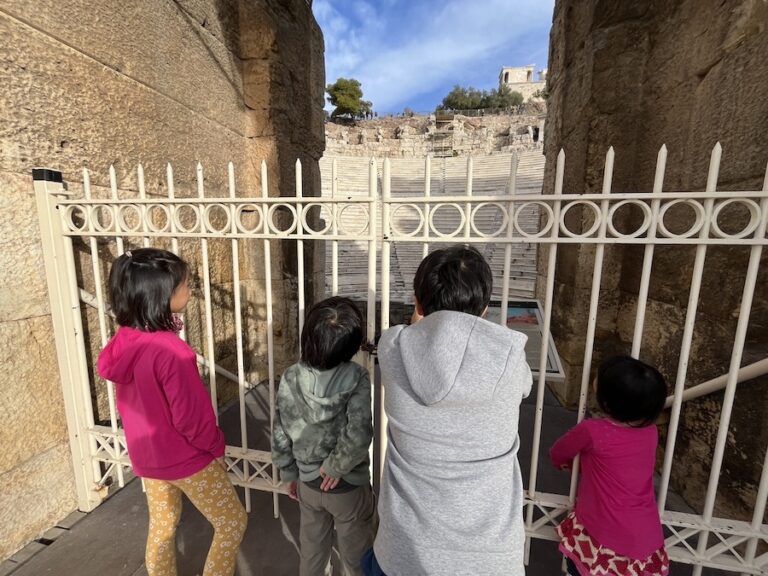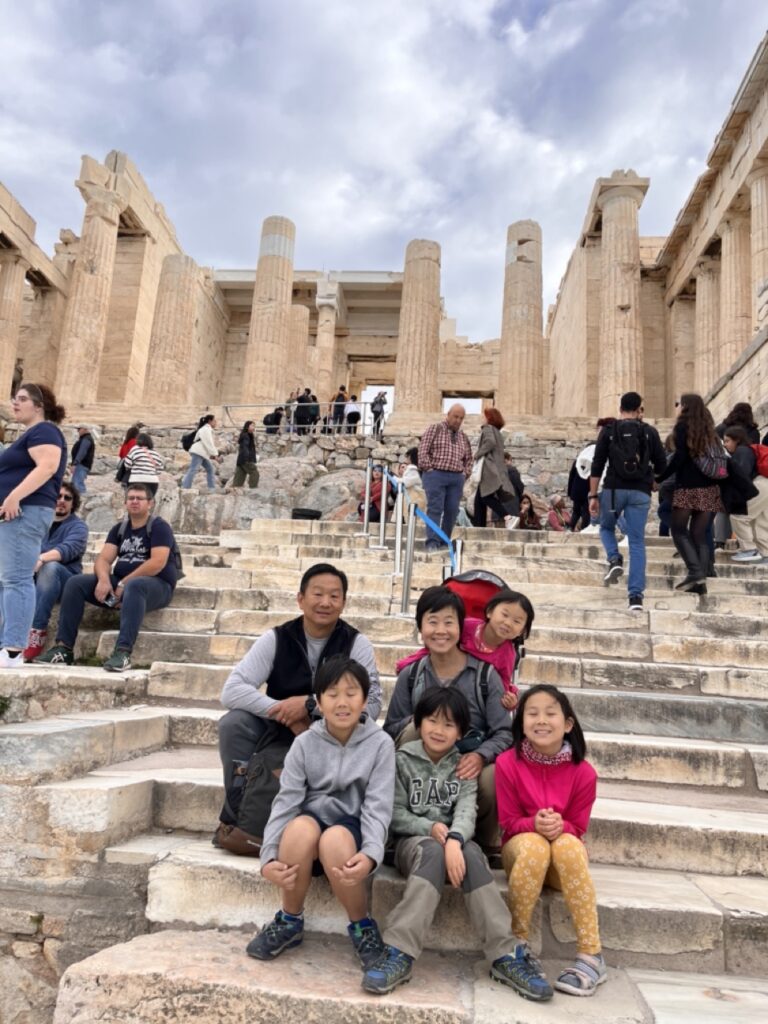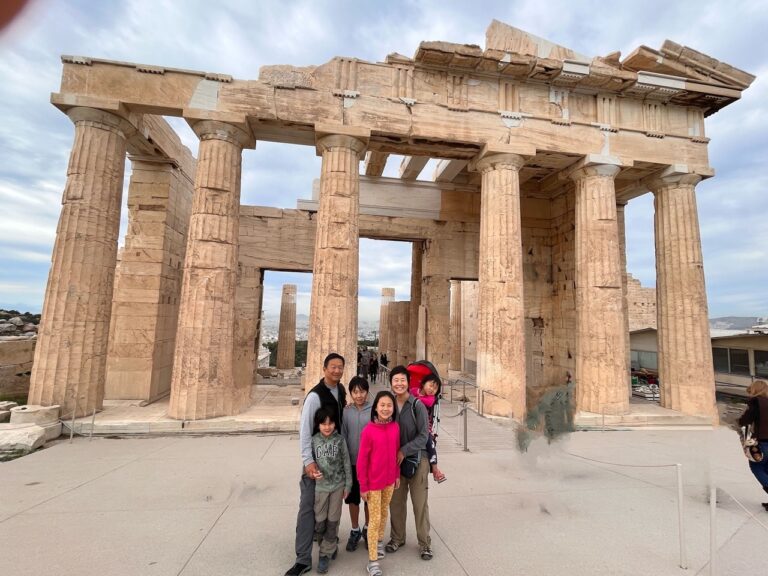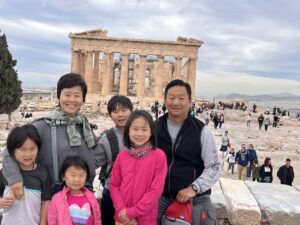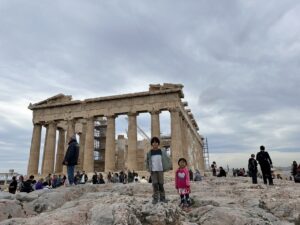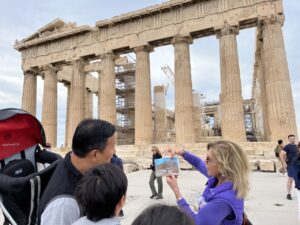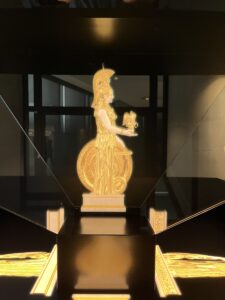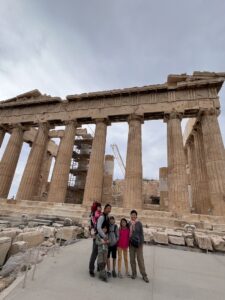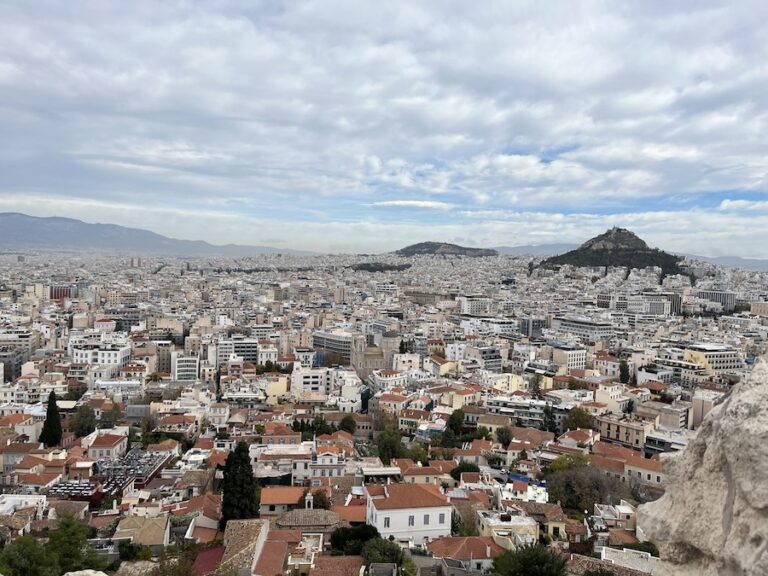The Acropolis is a symbol of Greek history, civilization and culture. It is one of the most famous archaeological sites in the world and arguably the most recognized landmark in the Western world. When we first arrived in Athens, the driver that drove us from the airport to our Airbnb told us that construction in Athens is subject to a height restriction so that every citizen has a view of the Acropolis. I looked it up on the internet to see if what he said is true. It is. The maximum height for buildings in Athens is six stories .
The last time I was in Greece, just after I graduated from college, I remember visiting the Parthenon and sort of just stumbled my way through the sites without a good understanding of what I was seeing. If you visit a place without any lasting memory of it, did you actually visit that place? This time around, I wanted to make the most of our visit so years later, I wouldn’t feel like we ambled our way through without remembering what we saw.
We hired a guide to help connect us to this experience. I enjoy seeing a place through the eyes of a local because the visit becomes more than just learning about a place or a transfer of knowledge. It becomes a connection, something deeper. You can often feel the love and pride, sometimes pain or regret, they have for their homeland reflected in the light in their eyes or the inflection in their voice.
Our guide at the Acropolis was a middle-aged Athenian named Thenia and we spent several lovely hours with her as she guided us around the “Sacred Rock”. We met at the Acropoli metro station on an overcast Saturday morning. There weren’t many people around the station so I was hopeful that the sight wouldn’t be too crowded.
The word “Acropolis” in Greek, means “city at the top”. It is a generic term that refers to any main hilltop citadel, fort or palace with defensive purposes as well as municipal and religious functions. Every city of that time period in Greece had an acropolis. It is just that the acropolis in Athens was the most famous. Hence, when people say the “Acropolis”, it is understood that they are referring to the Acropolis of Athens.
The sight and structures that we recognize as the Acropolis was built during the latter-half of the 5th century BC by Pericles during the Golden Age of Athens between 460 to 430 BC. Prior to that, the sight itself had already been used for over a thousand years. The earliest recorded history shows the Myceneans surrounding the hill with a thick wall and building a compound at the top of the hill for the local ruler and his family. Sometime during the 6th century BC, Athenians built a Doric temple dedicated to Athena that they called “Bluebeard Temple.” Another temple or two were built at the site during the following years. Just about everything was torched and demolished by the Persians when they invaded Athens in 480 BC. After the end of the Persian War, Pericles had the ambitious plan to rebuild Athens and return it to its former glory. It is Pericles’ Acropolis that we see today.
For the next 50 years, architects hand-picked by Pericles continued to construct, even after his death, the iconic temples and monuments that stand to this day.
From the Acropoli metro station, we passed the new Acropolis Museum and Thenia led us on a short walk along Dionysiou Areopagitou, a peaceful pedestrian street. One side of the street is lined with fancy neoclassical residential buildings while the other side offers views of the Parthenon. We stopped to take a peek past the gates and into the Odeon of Herodes Atticus, an open-air amphitheater located on the southern slope of the Acropolis. It was constructed in the 2nd century AD, some 500 years after the construction of the Parthenon. The acoustics in the theater are so sharp that performers do not need a microphone, even in the open air. Plays and musical performances are still held at the Odeon during the summer months.
We continued our climb up the hill toward the visitor entrance of the Acropolis. We had already booked tickets online so entering only required scanning the QR code. Thenia told us that we could store our stroller and even exchange it for a baby backpack carrier. EY didn’t really need it and she is getting too big for that kind of thing, but I thought she would enjoy sitting in it just for fun.
We entered the Acropolis through the Propylaea, the monumental entryway into the Acropolis. Built around 437 BC, it was one of the final phases of Pericles’ ambitious rebuilding program and was only added when the Parthenon and the Temple of Athena neared completion. It was never completed because of the start of the Peloponnesian War.
The Parthenon, considered the paragon of architectural perfection, is the largest structure and main temple on the Acropolis dedicated to the goddess Athena, the city’s patron goddess. It was the centerpiece of Pericles’ Acropolis building plan and was completed in 438 BC. It was constructed of Pendeli marble and even though it looks almost entirely white today, it was most likely painted in vibrant colors. Thenia asked us to look closely whether the columns of the Parthenon were straight. They looked pretty straight to us. Actually, there are a number of what she called “optical illusions” but I think she meant “optical refinements” like inward leaning columns, domed base and wider corner columns that make it appear to the human eye, that everything is straight and balanced. In fact, there are few perfect lines in the Parthenon.
Today, the Parthenon is the main attraction at the Acropolis. In antiquity, the original main attraction was a 12-meter-tall statue of Athena made of wood and covered in ivory and gold. The Parthenon was actually constructed to house this glorious statue that cost more to construct than the building that surrounded it. In fact, the word parthanos means “maiden” and was one of the names for Athena. The wealth of the city was fitted onto the statue of Athena in the form of gold clothing, a shield, helmet and accessories. In times of need, the gold could be stripped off of the statue and melted. The statue of Athena remained the symbol of Athens for nearly a thousand years. Nobody knows for sure, but at some point, it was taken to Constantinople where it was likely destroyed and scrapped by the Ottomans. When we visited the Acropolis Museum, we saw a 3D hologram of the statue of Athena. It was indeed covered in gold.
Our kids were thrilled to be in the land of Greek mythology. Throughout our roadtrip in South Africa, they listened a lot to the podcast, “Greeking Out” and can pretty much tell you everything you ever wanted to know about Greek gods and goddesses and their stories. Anytime Thenia mentioned Athena, Poseidon, Zeus or any of their coherts, their ears perked up and their eyes moved from side to side in deep recall. I don’t think Thenia told them anything totally new, but they enjoyed confirming and sometimes challenging details of stories that differed slightly.
The Erechtheion is an ionic temple dedicated to Athena, housing the wooden cult statue of Athena, and Poseiden-Erechtheus in a lower chamber. It was constructed around the last twenty years of the 5th century BC. Thenia told us a story about the competition between Athena and Poseidon to be recognized as the patron god of Athens. They were challenged to present their most valuable contribution. Poseidon stamped his trident on the ground, creating a hole on the north porch of the Erechtheion, causing a storm to well up in the sea. Athena presented an olive tree, which was selected as a greater ability. Thus, Athena was chosen as the patron goddess of Athens.
The most recognizable features of the Erechtheion are the six Caryatid maiden statues that support the roof of the south porch. All of the maidens appear to be similar, but they each have different hairstyles. During Ancient times, they were vibrantly painted but the color has faded over the ages. The Caryatids at the Erechtheion are replicas. Five of the originals are housed in the Acropolis Museum and the sixth is held at the British Museum. The sixth Caryatid was hauled off, together with other reliefs and statues, by Lord Elgin who had the approval of the Ottoman Empire who ruled Greece at the end of the 19th century, to cart away priceless treasures from the Parthenon which he eventually sold to the British Museum.
The Acropolis has survived various religions and invaders and even wars. In the 6th century AD, when the Christians overtook Greece, they outlawed the worship of pagan gods and converted the various temples on the Acropolis into Christian churches, the Parthenon was dedicated to the Virgin Mary. When the Ottomans invaded in the mid-1400s AD, the temples were then converted into mosques. At one point, the Parthenon was used as a warehouse for ammunitions and army barracks. By the late 1700s, the Parthenon was basically in ruins with many of its treasures being looted and vandalized. It was only at the beginning of the 20th century that real restoration work began with the goal of conserving the history of the Acropolis and restoring its structures as closely to their original state as possible.
When we visited, there was visible scaffolding up in the Parthenon. Thenia told us they have been working like this for as long as she could remember, but restoration should be complete in the next couple years.
After viewing all of the ancient sites on the Acropolis, our eye was naturally drawn to the Greek flag blowing proudly in the wind. We walked toward the flag standing on Belvedere Tower, located on the eastern side of the Acropolis. The flag is a symbol of national pride and Nazi resistance. When the Nazis began their occupation of Greece in 1941, they ordered the Greek soldier on duty, named Konstantinos Koukidis, to take the Greek flag down and fly the Nazi swastika flag. The soldier calmly took the flag down and draped it over his shoulders. He then jumped off the tower to his death in an act of defiance. A month later, two teenagers named Lakis Santas and Manolis Glezos snuck into the Acropolis through ancient passageways they learned about from reading old Greek texts. They tore the Nazi flag down leaving an empty flag pole that was only discovered by the Nazis the next morning. This act of defiance came to symbolize the Greek resistance against the Nazis.
We ended our tour with Thenia by taking a photo from this spot, overlooking the great city of Athens with the Temple of Olympian Zeus visible in the background.
Author
-

Song is the mother of four children. She and her family have stepped away from it all and in September 2023, began traveling the world while homeschooling. Song is an ABC (American born Chinese) and has an undergraduate degree from Cornell and an MBA from Harvard. She is an entrepreneur and an educator. Her hobbies include learning, traveling, reading, cooking and baking, and being with children.


